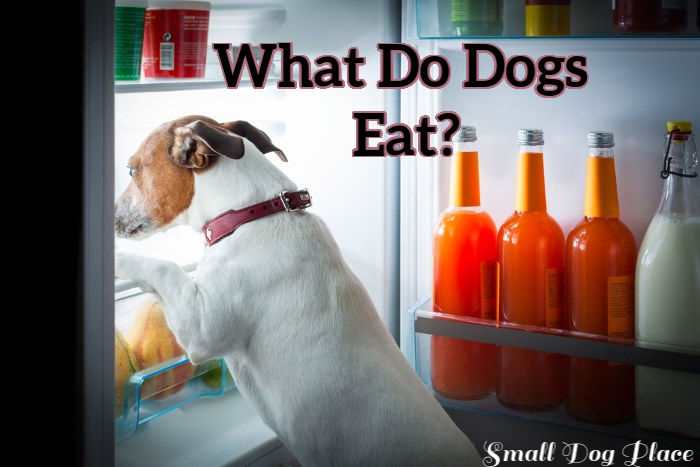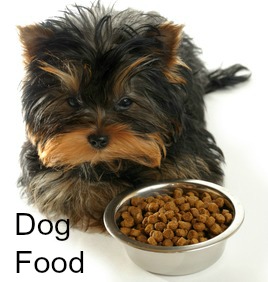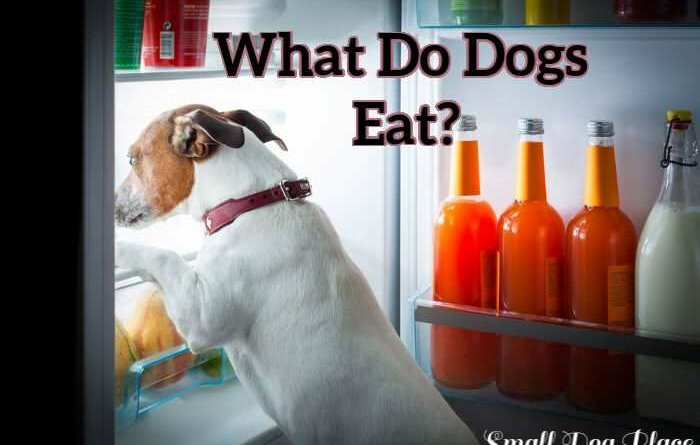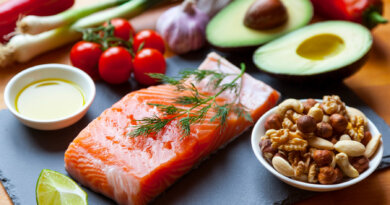What do dogs eat? Pros and Cons of the Major Types of Food
What to Feed Your Dog By Janice Jones |Last Updated 10/24/2019
The simple question, of what to feed your dog does not have a simple answer. Anyone who has ever ventured into a pet store can attest to the fact that there is more shelf room devoted to pet foods than all other products combined.
In fact, according to the American Pet Products Association (APPA), U.S. citizens are estimated to spend over $60 billion on their pets in 2015. Of that, the organization determines that more than 20 billion dollars will be spent on food.

Americans love their pets and will spend much money to assure their pets are healthy, happy and pampered.
Since dog food expenses are such a large portion of the yearly budget, it makes sense to assure that you are getting your money’s worth.
Whether you are a new dog owner or experienced, providing the right diet for your dog should be a priority.
There are so many stories about dog food circulating over the net, some are factual and some are not. It is not surprising that people are confused.
Dog Food Choices
 What do Dogs Eat?
What do Dogs Eat?While it might seem the choices are endless, it is often easier to break down the task of deciding on a dog food. Before going into the thousands of brands available today, let’s look at each of your options.
There are basically two ways to provide food for your dog:
Cook it yourself or Buy it already prepared. Or, combine the two.
Sounds simple? Well, maybe it is not that simple. So, what do dogs eat? You have many choices…
There are many options within each of these categories so we’ll look at each one separately:
Homemade or Commercially Prepared
Raw or Cooked
Wet, Dry,or Semi-Moist
Dehydrated, Freeze-Dried,
Refrigerated or Frozen
Fresh
Before getting into the nitty-gritty of the dog food industry, it you are interested, may I suggest reviewing a bit about dog nutrition. Here are a couple of articles you might find helpful.
Nutritional Needs of Small Dogs
Small Breed Dog Foods: Critical Factors to Consider
Free Feeding versus Scheduled Meal Time
When and How to feed
Foods that Dogs Should Not Eat
Vegetables Dogs Can Eat
What do Dogs Eat? Homemade Cooked or Raw
Homemade food for a dog is not a new trend, rather it was the
standard way to feed dogs prior to the dawn of the commercial
dog food industry.
Years ago, we would have called it table scraps.
Today
a home-cooked dog food diet is anything but table scraps.
The trend
towards both the raw diet and the home-made diet increased after the dog
food recalls that occurred a few years back.
People wanted to
know and control what their dog was eating.
The major advantage of
cooked foods over raw is the elimination of any possible risks of
bacterial infections stemming from raw meat. There are benefits to raw food too, and we’ll get into that in just a moment.
The advantage of a
homemade diet is that you can control everything your dog eats.
You can provide top quality ingredients and prepare it safely. No need to worry about contamination.
The downside is that it
is not as easy as it sounds. Commercial dog food companies spend
countless sums of money to research dog nutrition so that their product
will contain the right ingredients in the right quantities.
You might also be surprised that to learn that it is not as cheap as it might first sound.
If you purchase all of your vegetables from locally grown farmers’ markets, visit the farm to get farm-fresh eggs, buy all your meat from the local butcher or grow your vegetables, then you are off to a good start to providing a high quality homemade diet.
So the price of the food depends on where you shop and the quality of the ingredients to use. It is more time-consuming and may not be practical if you travel.
The nutrients that you add to your dog’s evening stew might be top notch, but unless you are well versed in canine nutrition, you may not be providing a well-balanced, complete diet unless you supplement.
If cooking for your dog sounds like something you might want to do, yet aren’t sure how to begin, I would recommend you visit Easy-Food-Dehydrating to get some pointers, a free recipe, and even a helpful video tutorial.
There is also some very helpful advice about what supplements you can add to assure your dog is getting all the correct vitamins and minerals he needs.
What do dogs eat?
Pros and Cons of Homemade Diets
Homemade Diet: Pros:
- No need to
ever worry about dog food recalls - Can control
the ingredients that go into the diet - Can control
how the food is being prepared - Some claim Health
benefits - Fun activity if you like to cook
Homemade Diet: Cons
- Can be
expensive - May also be less expensive
- Time
consuming - Learning-curve
to understanding basic canine nutrition - May need to
provide supplements - May not be
practical for people who travel or board their pets
Read more about Home-cooked Meals for Your Dog
Home-cooked Meals: 8 Ingredients to add on a Regular Basis.
Commercially Available Dog Food
Most people will choose a commercially available food for their dog because of the convenience of not needing to cook. Costs and ease of feeding are two other factors to take into consideration. But choosing the right one for your dog is anything but simple.
There are so many dog food choices that food manufacturers must go to great lengths to encourage you to buy their brands.
The advertising is seductive and often misleading. They use words we want to hear such as “natural” or “holistic” but in reality, do not have much meaning.
Commercial diets come in different forms including
- Canned or wet
- Dry or kibble
- Semi-moist
- Frozen
- Raw (can be homemade or commercially available)
- Dehydrated (you can also choose to prepare your food yourself in a dehydrated form.
- Freeze dried
- Refrigerated / Fresh
To make it even more complicated, within each of these categories listed above, any manufacturers give even more options.
Let’s take dry kibble for example, years ago all you needed to do was buy a bag of food, take it home, open it and pour into a bowl.
We have come a long way from the “good ol days.”
We’re bombarded with choices that include:
1. Formulas based on the life stage (adult, puppy, senior) or the lifestyle (active, obese, athletic, sedentary, nursing, pregnant)
2. Some foods such as the veterinary formulas that aim to correct a medical problem such as kidney, GI tract or Allergies.
3. Other choices include selecting the correct food for the size of the breed (small dog puppy or large adult dog)
4. Some are even formulated for a specific breed.
5. Food manufacturers also focus on ingredients and specialty blends, such as chicken, turkey, lamb, salmon, white fish or more exotic such as duck, bison, or kangaroo). Some may be all meat, low carb, low fat or one protein source.
6. One must then decide whether to feed grain free, good grains, or save money and purchase foods with all types of grains. Vegan diet anyone?
7. Add to the mix, organic, natural and holistic blends.
WOW, that’s a lot of decisions to make even before you ever set foot in a pet store or venture online.
So, before I confuse you even more, let’s get back to the major forms of food.
What do Dogs Eat? Dry Dog Food or Kibble
Dry food or kibble is the most economical food and has a
shelf life from 6 months to 1 year.
There is no need to refrigerate it and it is very easy to serve. For these reasons, most dog owners prefer dry
food over other types.
There are a
plethora of brands to choose from and the nutritional value can range from
excellent to extremely poor.
It is
readily available at supermarkets, pet stores and online. Reading the dog food label will give you some idea
what you are serving to your dog.
Dry dog food comes in all the options listed above.
What do dogs Eat?
Pros and Cons of Dry Foods
Dry Food: Pros
- Little or no odor
- Less expensive
- Easy to serve
- No refrigeration needed
- Good for giving a dog a good chewing experience
- Help keep the mouth cleaner by reducing the buildup of plaque
- Can be left out and will not spoil as quickly as canned food
- Foods marked as complete and balanced are researched to provide total nutrition without the need to offer supplements
- Plenty of variety, costs vary
Dry Food: Cons
- Some dogs may not eat it
- The shelf life is not as long as canned
- Wide range of quality from very good to very poor
- May experience dog food recalls
- Questionable ingredients
What do Dogs Eat? Canned Dog Food
Canned dog foods are the next most common food served to dogs. Although more expensive, the shelf life is long and most cans come with pop off lids eliminating the need for a can opener.
Since canned foods have high water content, you will need to serve more to get the same nutritional value as a lesser amount of dry food. The main advantage and the reason so many small dog owners serve canned is the taste—their dogs gobble it up.
As with dry foods, can food can be very low in quantity to very high and range in price from $ .50 a can to upwards of $4.00 per can with the premium brands being the most expensive. These prices are based on a survey done at the writing of this article.
What do Dogs Eat?
Pros and Cons of Canned Foods
Pros of Canned Food
- Keeps much longer (until you open the can)
- Some dogs prefer the taste of canned dog food
- May be more suitable for some medical conditions that require higher water intake.
- May have fewer preservatives than dry dog foods
- Much higher water content which is good if the dog doesn’t drink enough water. (>70%)
- Variety in brands, formulas, ingredients
Cons of Canned Food
- More expensive than dry or semi-moist
- Must be refrigerated
- May have a disagreeable odor
- Cannot be left out all day as it will attract insects and spoil
- May experience dog food recalls
- Questionable ingredients
If you are considering canned food as your dog’s primary diet, I would suggest you stop by Zoobio to check out their guidelines on proper rationing of the diet.
What do Dogs Eat? Semi-moist (Treats)
Semi-moist dog foods have a moisture content of 25-40%, which falls between canned and dry food. Semi-moist foods were once very popular as an alternative to canned foods; now they have fallen out of favor due to the high quantity of artificial colors and flavorings and high quantity of preservatives used in processing.
Many of the semi-moist foods today are sold as treats and you will find them shaped like little pork chops, bones, or hamburgers. Semi moist is the least nutritious of the commercially prepared dog foods.
BUT, if you are in the process of training your dog and need tiny tidbits to entice him to obey your commands, then be aware that this form of food adds calories, so my advice? Break them into tiny pieces.
Pros and Cons of Semi-Moist Foods (Treats)
Semi-Moist: Pros
- Cost is
lower than canned food - Convenient
packaging - Easy to
serve - No need for
refrigeration
Semi-Moist: Cons
- Nutritional
Value is low - Leads to
dental problems - Large
quantities of preservatives, artificial colors and flavorings
What do Dogs Eat? Dehydrated Foods
Dehydrated foods are often confused with “freeze-dried because they often look alike. Dehydrate foods are cooked at lower temperatures for shorter periods of time. Some are not cooked at all (raw).
This process allows the nutrients from the food to remain so that artificial supplements may not need to be added. Their moisture content is removed through drying so you may need to re-hydrate them before serving. Removing the moisture increases their shelf life.
They require less preservatives due to the way they are prepared. They are more expensive than the dry kibble that we discussed above.
Freeze-dried foods are created by a process that involves quick freezing and then cooking to remove the moisture. Both foods end up the same. These are costly foods ranging in price from $7.00 to $15.00 per pound.
Dogs normally won’t eat as much of this product as regular kibble.
Pros and Cons of Dehydrated, Freeze-Dry Food
Pros of Dehydrated Foods
- Less processing means more nutritious
- Both cooked and raw diets use the dehydration process
- Less messy than fresh or canned
- Fewer preservatives
Cons of Dehydrated Foods
- Costly
- May not be available in all pet stores
What do Dogs Eat? Raw Food Diet
The newest trend that has emerged in recent years is the raw diet. While not without controversy, it is gaining in popularity due to the belief that raw represents a natural alternative to processed food, originating in our small dog’s ancestral past.
A raw diet consists of raw muscle meat, meaty bones, organs mixed in, fruits and vegetables, but usually no grains. Vitamins and minerals are often added into the mixture. Bones are a natural source of phosphorus and calcium.
This type of diet works well for dogs because they have short intestinal tracts and strong stomach acids. A dog’s anatomy allows them to consume and digest raw food quickly before any harmful bacteria can multiply and take over.
Raw foods can be fresh, frozen, or dehydrated/freeze-dried. Some foods are sold as partial diets that can be included in homemade meals.
This trend towards raw is fueled by devoted owners and enthusiastic who claim that dogs live longer healthier lives on this type of diet. Before you decide on a raw diet, it is advisable to talk to your veterinarian about the benefits and risks.
People who place their dogs on this type of diet rave about the many health benefits. Most of what is known about the benefits comes from people who use raw. There have not been many research studies confirming these claims.
Costs can vary widely depending on your source of raw ingredients. The least expensive option would be a local source. The most expensive would be online purchases where you would need to add in the cost of shipping.
Pros and Cons of Raw
Raw Food Diet: Pros
- Healthier, longer-lived dogs
- More natural diet for dogs
- Easier to digest
- Less dental problems
Raw Food Diet: Cons
- Most costly
- More time consuming to prepare
- Requires additional supplements to assure
complete nutrition - May introduce harmful bacteria
- Not well researched
Read more about Raw Dog Food Diets
Is Your Raw Dog Diet Causing Diarrhea?
What do Dogs Eat: Fresh Dog Food
One of the newer methods of feeding your dog involves purchasing ready-made meals on line that are personalized to your dog’s breed, age, activity level, and health problems. Companies that provide this service will ask you to fill out a questionnaire with all the details of your dog and then make recommendations based on how you answer the questions.
For example, Spot & Tango uses locally sourced fresh ingredients in the proper amounts and then adds in all the necessary vitamins and minerals so that each meal is nutritionally complete. This is the tricky part and the step that people how prepare home made meals at home often do not get right. The other advantage to using fresh foods is they are normally come in individually portioned pouches so there is no guess work.
Pros and Cons of Fresh-Dog-Food
Fresh foods: Pros
- Much more palatable for even finicky eaters
- Normally delivered to your door in sealed, frozen individually portioned meals
- Healthier because nutrients are not lost in the manufacturing process
- Easier to digest
- Meals can remain frozen or refrigerated until serving
- Easy to serve (open pouch and spoon into dog dish)
Fresh foods: Cons
- More costly
- May need extra planning if you travel frequently with your dog
- You won’t want to leave the food out in room temperate for too long so a bit more monitoring of meal time is necessary
Does This Article Deserve Your Thumbs Up?
We always appreciate your support and encouragement. Your thumbs up means so much to us.

Free Monthly Newsletter
Sign Up for Our Free Newsletter and get our Free Gift to You.
my E-book, The Top 10 Mistakes People Make When Choosing a Dog (and how to avoid them)
If you enjoyed this page, I’d love it if you’d let me know. Just click the button below. Thank you.
Sharing is Caring




mexican mail order pharmacies https://mexicanpharmacy.life/# – mexican online pharmacies prescription drugs
top 10 pharmacies in india https://indiapharmacy.world/# – best online pharmacy india